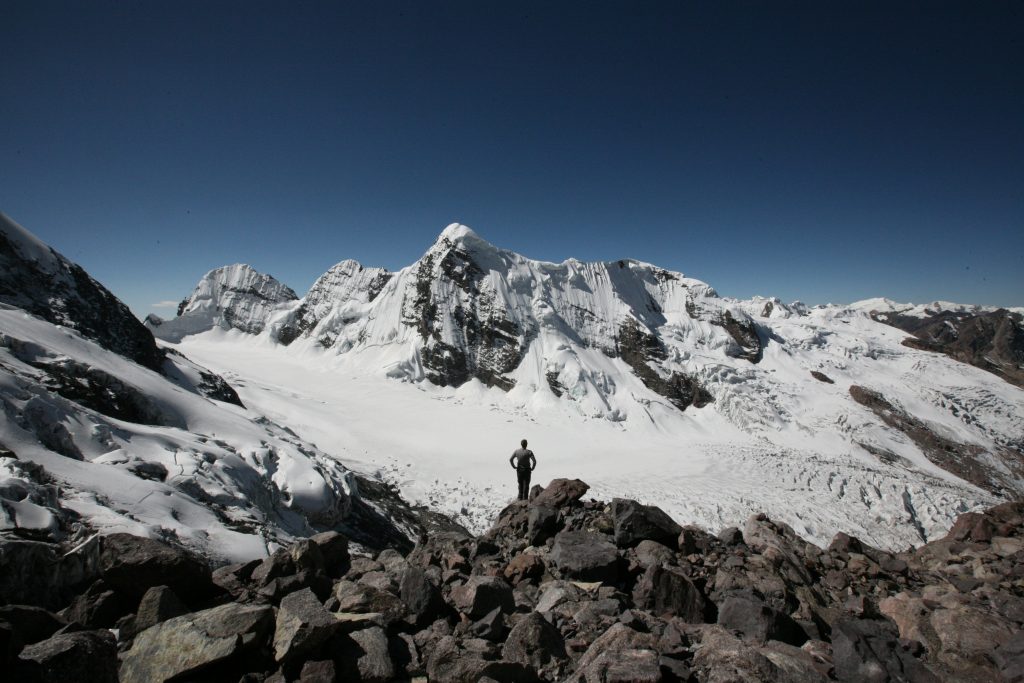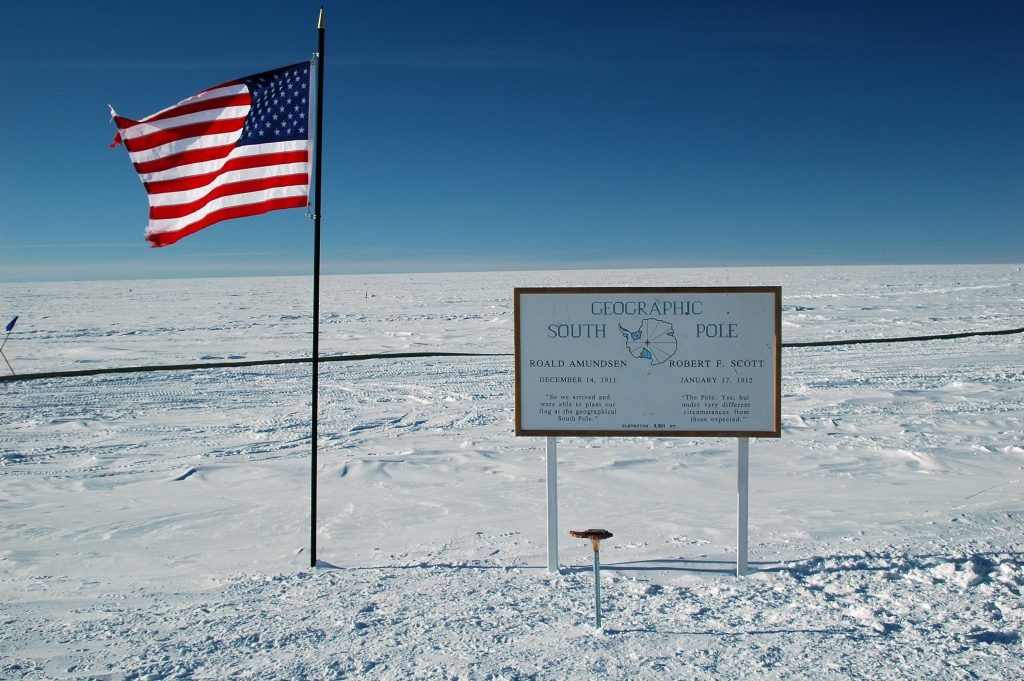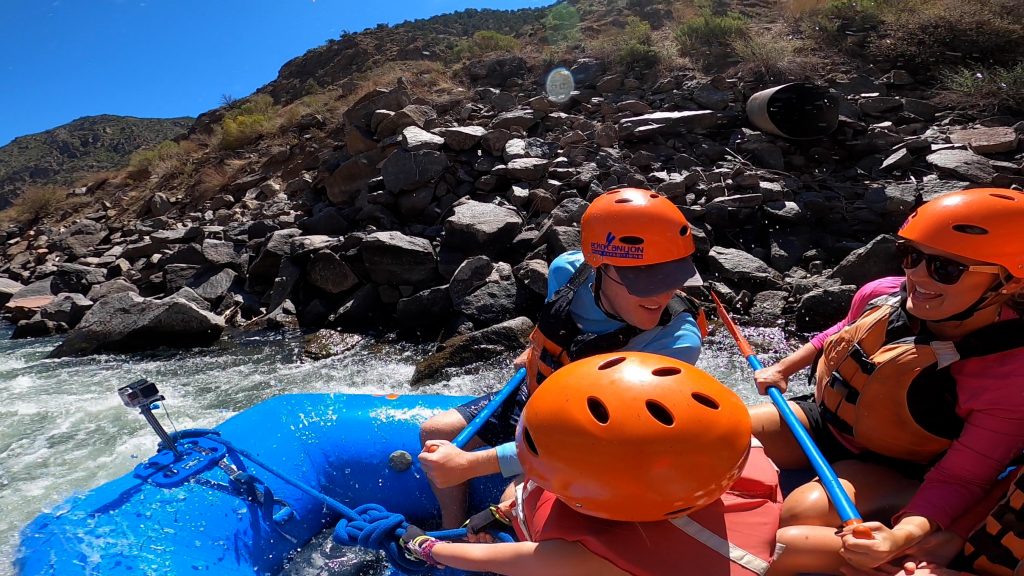The Sierra has truly been blessed this year with record snow fall. So, although the weather this spring and early summer has been warm, there is still plenty of snow in the beautiful backcountry. With that in mind, some colleagues at Atlas Snow-Shoe Company came up with the wild idea to do a traditional skiing route across the Sierra-Nevada mountain range on snowshoes. While this was admittedly for our own personal fun, we could justify it as a work trip to test the snowshoes.
The result was a 45 mile trek across the breadth of the Sierra. We started just east of Independence, off Highway 395, and hiked up Symmes Creek. After 12,000 feet of vertical gain and traveling and camping for six days above 11,000 feet, we arrived at the Wolverton Ski Area in Sequoia National Park. The route is usually done on skis with a few mountaineering sections to get over the highest passes, including Milestone Col on the Great Western Divide at over 13,000 feet.
The epic journey was filled with the thrill of the unknown. Atlas general manager Daniel Emerson, product engineer Peter Chapman, Explore Winter Women’s Workshop manager Teri Smith, and me, as expedition photographer, strapped on some of the company’s newest products and set off.
We pushed our physical and technical limits, and discovered how truly rugged and functional our snowshoes turned out to be when tested hard. Best of all, we enjoyed a great bonding and maturing of friendships with each other.
In the end, we came away with an unforgettable experience, great photos and one very important piece of advice: Snowshoes are the ticket for accessing the winter backcountry if you don’t want to bother with the technical aspect or steep learning curve of skiing or snowboarding.
Day 1, Symmes Creek Trailhead
Elevation: 6,300 feet
We started at Symmes Creek, one of the main eastern gateways into the Sierra-Nevada. The trailhead lies just west of Independence, California, in the Owens Valley, at 6,300 feet. At that elevation we were still below the snow line.
Bending under our bursting packs, we bade farewell to our support team and started up along Symmes Creek carrying our snowshoes. Once through the half mile-long gorge, we had to pick our way through a messy pile of avalanche debris. After two hours, the terrain leveled for a moment and we took our first break. We had gained 1000 feet, but the north-facing slope continued above us. We unhooked our snowshoes from our packs, strapped in, and continued up. A faint pair of ski tracks zig-zagged up around us while we charged straight up, not bothering to ascend in the switchback fashion that skiers are confined to.
Being early in the trip our packs were heavy, so we took frequent brief breaks. We finally crested the ridge separating Symmes and Shepherd Creeks and voted unanimously to stop there for lunch. At 9,090 feet we found a clear patch of dry ground to setup our first mountain meal of the trip.
After lunch the terrain alternated between snowy northern aspect slopes and dry southern aspects along the dusty trail. At first we tried leaving our snowshoes on for the dry patches, but soon realized it was ridiculous to plod along wearing snowshoes in the dirt. In the end, the snowy northern slopes were firm enough to go without snowshoes until we reached Shepherd Creek. From there, we’d have snow the rest of the way.
After one last big push up a steep, snowy face, we reached a small plateau and our first camp. We had just reched 10,000 feet and there was still more uphill work to do. Behind, we could see all the way down to the brown Owens Valley, now enshrouded in the long shadow of the Sierra. A quick change into dry clothes, setting up our shelter and making dinner were the top priorities. Soon after sunset the cold set in quickly, and after a dinner of hot lasagna we were just as quick to jump into bed.
Day 2, Shepherd Creek
Elevation: 10,100 feet
The next morning, I was up to watch the sun rise. After some oatmeal and attempts to fit all this stuff back into our packs, we were moving again, ever upward. Now, the trees, which had been our steady companions all the way from Symmes Creek, slowly thinned out and finally disappeared.
In cold and windy conditions, we reached the headwall below the pass and punched our way up a bullet-proof slope to Shepherd Pass. Three-quarters of the way up the 800-foot headwall. We were sidestepping like inchworms and toe-punching the toe cleats of the snowshoes into the icy slope, working our way across. Every step required concentration to ensure a good purchase with our poles and the front cleats of our snowshoes. The wind howled, adding to the intensity of the climb.
Near the crest of the pass, I was happy to lay down for a minute and share a snack with the group before pushing on up and over the pass. This time, Daniel and I led while Peter and Teri brought up the rear. The winds remained strong and threw fragments of snow and ice at us as we continued charging the slope. To relieve our burning calves, we would scout out spots where we could set our heels down and rest between stints of punching up on our toes. After a half dozen such stops we finally crested the pass and took in the view of the gentle snow-covered upper Tyndall basin, the impressive Diamond Mesa and down into the upper reaches of the massive Kern valley.
From here, it was a gentle tromp down around the toe of Diamond Mesa, and finally after cresting over and down a few small ridges, Camp II. Teri and Peter were in the lead and found a small island of trees and boulders to act as a windbreak for our camp. They immediately started digging out our shelter while Daniel and I concentrated on getting the kitchen up and running. Soon enough, we had our shelter set up, hot drinks in hand and dinner gurgling away in the big pot.
Day 3, Tyndall Creek
Elevation: 11,511 feet
Another early rise put me on the crest of the hill near our camp waiting for the sun. As it worked its way up from behind the eastern range, the light spilled out onto Kern Ridge in the west, our objective for today. Departing camp, we continued toward the Kern Valley from a side plateau and were soon traversing along the headwall.
From the headwaters of the Kern, we started going up again. This time we worked our way west up Milestone Creek, guided by the 13,638-foot monolithic spire of rock that is Milestone Mountain. Fueled up after a big lunch of cheese and sausage at 11,000 feet, we broke above the timberline again and marched west. At this point the sun had already reached its zenith for the day and our shadows slowly elongated behind us.
After the mild rolling terrain of the lower part of the Milestone ravine, we confronted the steep rock-strewn talus slope just below Milestone Mountain. The sun was now well ahead of us and the shadow of Milestone Mountain was creeping down as we continued to work our way up. When the shadow overtook us, the temperature took a drastic dive and the wind started up afresh.
Peter found a manageable way over the col, and the rest of us followed. The higher we climbed, dodging our way through the scattered boulders which have fallen from the top of the mountain, the steeper it got. On a small ledge, we got out of our snowshoes and scrambled up a 50 foot, grade III stack of rocks to gain the 13,000-foot col.
Once on the ridge, we were back in the streaming sunlight, orange now from its lower position in the sky. From Milestone Mountain, the craggy Kern Ridge jutted away from the Great Western Divide. The light did not last however, and before we started our steep descent into Milestone Bowl the shadow of the Great Western Divide overtook us.
The climb down was steep and slow. It was 7 p.m. before we got Camp III established, and one team member was stricken with a mild case of hypothermia. This required the dedicated attention of a second team member while the remaining two built the shelter and supplied hot drinks and dinner.
Day 4, Upper Milestone Bowl
Elevation: 12,463 feet
The sun did not find us until late the next morning because of our encampment low on the western slope of the Kern Ridge. The welcome sunlight brought the temperature way up, enough that Peter and I could go without our shirts while packing up in order to catch some rays.
We continued down Milestone Bowl and started scoping out possible route lines to work our way out of the adjoining bowl below Colby Pass. As we looked across the basin to the slope that would be our next climb, concerns about fatigue drove questions about the route options. The next climb looked steep and we talked about diverging from the planned route and walking around the ridge jutting from the Great Western Divide. Deep in the basin, we broke for lunch. We discussed taking a half day, making camp here, to be rested for the grind up the slope above us in the morning. That’s what we did, but not until we hiked out to the end of the ridge and found the terrain impassable without dropping all the way down into the Kern-Kaweah River Valley.
It felt good to get camp set up early. Being at the bottom of the basin meant we didn’t have direct sunlight for too long, but we were well settled and the extra time around camp allowed for some innovation. We improved upon the trench-bench style kitchen Daniel conceived at Camp II and put it right next to the pit for the kiva. This made our community more intimate and the bulk of the kiva allowed us to cook protected from the wind. The flaps of the kiva folded out to form curtains that neatly framed the Black Kaweah range across the valley.
Day 5, Lower Milestone Basin
Elevation: 11,030 feet
Well fed and well rested, we started the climb that had turned us back the day before. The typical Sierra weather was welcome: full sun, blue sky, without any clouds to soften the rays. It didn’t take long for the sunshine to soften the snow on the east facing slope and with each step we would sink slightly deeper. The steps Peter punched before me held his weight, but I had to re-kick the steps and test each one for my own load.
From the top of the pass, the whole world seemed to stretch out before us. Behind us to the east we could just see over and along the Kern Ridge. North, the Great Western Divide stretched along side and ahead. The Great Western Divide collides with the Kings-Kaweah Divide at Triple Divide Peak. There, the southern half of the Great Western Divide continues south as the spine of the Sierra.
The ridge of the Great Western Divide is too precarious, so we had to dip down into the basin and only then work our way back up to Triple Divide Pass. The basin below was immense and the gentle rolling texture of its snow-covered landscape looked like soft billowing clouds. Soon we were punching our way back up the snowy slope before us. But with steady plodding we found ourselves celebrating in the saddle of yet another pass. This time we sat squarely on the Great Western Divide in Triple Divide Pass. Behind us, our tracks formed a winding line over the snow pillows in the basin and before us lay the head of Cloud Canyon and Glacier Lake below Triple Divide Peak.
After glissading down the steep slope from Triple Divide Pass we found an outcropping of exposed rock for lunch. Cloud Canyon opened up below and a prominent ragged spine of rock known as The Whale Back captivated us while we ate. After lunch, we crossed the centerline of Cloud Canyon. The snow was softer here than on the slope approaching Shepherd Pass and Milestone Col, so we could actually stand on the steps that were about six inches deep, instead of the toe-pointing we had done previously.
From the canyon it was a steady climb back up to Copper Mine Pass. From Triple Divide Peak, we parted with the Great Western Divide and started paralleling the Kings-Kaweah Divide, the boundary between the Kings Canyon National Park and Sequoia National Park. After punching up the steep couloir, we scrambled out of the shadows of Cloud Canyon and onto Glacier Ridge. From there we could see across Deadman Canyon, the next leg of our journey, to the distinct rock formation known as The Fin on the far ridge.
There’s only one way into Deadman Canyon from Glacier Ridge – a 50-degree-plus slope and narrow gully no wider than six feet for most of the 60-foot down climb. When we finally emerged from the chute, we glissaded down to a small crease in the pillow-like snowfield where we carved out our last camp of the trip.
Day 6 – Deadman Canyon
Elevation: 11,636 feet
After our triple-pass day – Colby, Triple Divide, and Copper Mine – we needed a solid night of sleep. But I was up again before the sun with my camera ready to see how the morning light would play on the east face of The Fin. We were soon traversing the upper bowl at the head of Deadman Canyon heading toward The Fin itself. Still hiking along the Kings-Kaweah Divide, we passed Elizabeth Pass to the south and crossed the divide over an unnamed pass at the base of The Fin’s northern prow. This dropped us down into the Lonely Lake basin where we traversed around the head of that canyon only to climb out and over a ridge on the western side of the bowl. From the newly gained ridge we could see across the Lone Pine Meadow Creek valley to the western side of the Great Western Divide.
The ridge we now stood on put us near the head of Buck Canyon and we made yet one more canyon head traverse – our third of the day. The last traverse and another minor ridge put us into the tablelands, an undulating mass of terrain where we saw the first evidence of ski tracks since day one.
After navigating our way through the irregular terrain we came out at the top of the Table Meadows bowl. Shortly after lunch, we met up with a grouip on skis heading up to do the same route, but in reverse. Like us in the beginning, they were moving slowly under the weight of packs bursting with food. We shared notes about the terrain ahead while they warned us we had more climbing to do before we got out. We made the navigation pretty easy for them. All they had to do was follow our tracks.
Soon we picked up the trail markers that would guide us back to the Wolverton Creek parking lot, humping it over the ridges separating Emerald and Heather lakes and finally working our way down the six-mile track to the parking lot at a balmy 7,000 feet. Late in the sunny day the snow at the lower elevations was getting slushy but was still underfoot all the way to the parking lot.
We didn’t rest long in the dappled rays of the setting sun before changing into the fresh clothes we’d left in my Trooper and driving out of Kings Canyon National Park. After the sun set, we made for a grungy group as we gathered around a tasty meal at Bear Mountain Pizza along Highway 180. Just hours off the route, we already started to reminisce of the journey just ended. It will be with us a lifetime.

 Like || Tweet || More Photos || Purchase Photo
Like || Tweet || More Photos || Purchase Photo Like || Tweet || More Photos || Purchase Photo
Like || Tweet || More Photos || Purchase Photo Like || Tweet || More Photos || Purchase Photo
Like || Tweet || More Photos || Purchase Photo Like || Tweet || More Photos || Purchase Photo
Like || Tweet || More Photos || Purchase Photo Like || Tweet || More Photos || Purchase Photo
Like || Tweet || More Photos || Purchase Photo Like || Tweet || More Photos || Purchase Photo
Like || Tweet || More Photos || Purchase Photo Like || Tweet || More Photos || Purchase Photo
Like || Tweet || More Photos || Purchase Photo



Comments